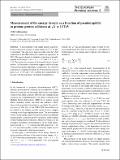Measurement of the energy density as a function of pseudorapidity in proton–proton collisions at $$\sqrt{s} =13\,\text {TeV} $$ s = 13 TeV
Author(s)
Sirunyan, A. M; Tumasyan, A.; Adam, W.; Ambrogi, F.; Asilar, E.; Bergauer, T.; Brandstetter, J.; Dragicevic, M.; Erö, J.; Del Valle, A. E; Flechl, M.; Frühwirth, R.; Ghete, V. M; Hrubec, J.; Jeitler, M.; Krammer, N.; Krätschmer, I.; Liko, D.; Madlener, T.; Mikulec, I.; ... Show more Show less
Download10052_2019_Article_6861.pdf (915.7Kb)
Publisher with Creative Commons License
Publisher with Creative Commons License
Creative Commons Attribution
Terms of use
Metadata
Show full item recordAbstract
Abstract
A measurement of the energy density in proton–proton collisions at a centre-of-mass energy of
$$\sqrt{s} =13$$
s
=
13
$$\,\text {TeV}$$
TeV
is presented. The data have been recorded with the CMS experiment at the LHC during low luminosity operations in 2015. The energy density is studied as a function of pseudorapidity in the ranges
$$-\,6.6<\eta <-\,5.2$$
-
6.6
<
η
<
-
5.2
and
$$3.15<|\eta |<5.20$$
3.15
<
|
η
|
<
5.20
. The results are compared with the predictions of several models. All the models considered suggest a different shape of the pseudorapidity dependence compared to that observed in the data. A comparison with LHC proton–proton collision data at
$$\sqrt{s} =0.9$$
s
=
0.9
and
$$7\,\text {TeV} $$
7
TeV
confirms the compatibility of the data with the hypothesis of limiting fragmentation.
Date issued
2019-05-07Department
Massachusetts Institute of Technology. Department of PhysicsPublisher
Springer Berlin Heidelberg
Citation
The European Physical Journal C. 2019 May 07;79(5):391
Version: Final published version